The best graphics cards in 2022

We are getting closer to that time of year when the best graphics cards might not be the best graphics cards for much longer. With new GPUs on the horizon, expect to see some of our favorite GPUs at the top of the list get replaced by something bigger and more powerful by Nvidia, AMD, and even Intel.
When shopping around for the best graphics card, you'll want one that provides a superior frame rate at the highest graphical settings at your preferred resolution. Oh, and it should also fit within your budget. Thankfully, the GPUs listed below offer the best performance-per-dollar value for PC gaming. The best part? Most of these graphics cards are becoming increasingly (and edging back to below MSRP) available as the Great GPU Shortage dramatically ends.
Nvidia and AMD couldn't be in better positions, both vying for the top spot in this generation with some truly competitive offerings. Throw in the Intel Arc Alchemist graphics cards later this year as a wild card, and you can expect to see things heat up as the next generation of GPUs enter our lives.
It's important to note that with new GPUs coming soon, expect more performance for less, though the more budget-conscious GPUs like the RTX 3060 or RX 6600 XT aren't likely to be replaced by shiny new cards immediately. However, if you're after something a little more high-powered, maybe wait a minute before splurging out on a GPU right now.
Best graphics card
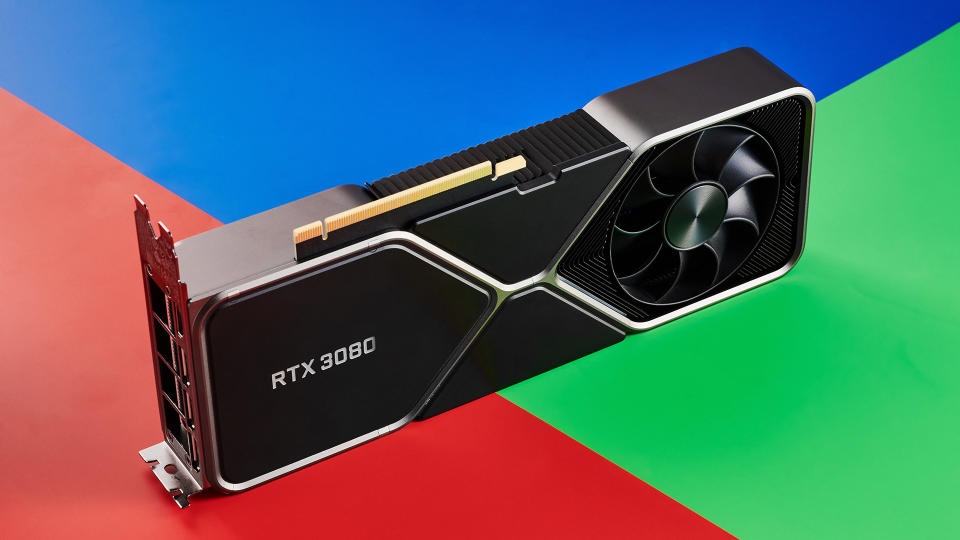
1. Nvidia GeForce RTX 3080 10GB
The best graphics card for PC gaming right now
CUDA cores: 8,704 | Base clock: 1,440MHz | Boost clock: 1,710MHz | TFLOPs: 29.76 | Memory: 10GB GDDR6X | Memory clock: 19GT/s | Memory bandwidth: 760GB/s
Incredible gen-on-gen performance
Makes 2080 Ti look mid-range
Ray tracing no longer a sacrifice
At launch it was one of the best deals in PC gaming history
Needs a beefy PSU
In high demand
There is a better 12GB model (though it is too expensive)
The RTX 3080 delivers the best performance per dollar for a high-end gaming PC. For a little while longer at least. And we're only talking about the 10GB one. At its original MSRP. There's also the 12GB RTX 3080, though that is even more expensive still.
I know, that is a lot of things to consider when buying a high-end GPU right now and that's largely because we're on the verge of a new GPU generation, following in the wake of a GPU shortage.
Though if you do pick up the RTX 3080 today it is a huge generational performance boost over the previous RTX 20-series. That's impressive when put up against either the RTX 2080 or 2080 Super, but when you consider that this nominally $699 card can not just match but massively outperform the $1,200 RTX 2080 Ti, it really hits home.
The thing which really stands out from our testing is the difference it makes to ray-tracing performance. The first generation of ray tracing-capable cards required such a huge frame rate sacrifice that most people shied away from turning it on, but that's no longer the case with this generation.
When you can now get ray-traced performance that exceeds the frame rates you'd get out of the top card of the RTX 20-series when running without it, you know that this is a whole different beast. And hey, the RTX 3080 can actually run Crysis.
The RTX 3080 represents a huge generational performance boost over the previous RTX 20-series.
Nvidia has managed this by adding a whole load more CUDA cores to the mix in this 8nm GPU and updated Tensor Cores (for extra DLSS goodness) and second-gen RT Cores to make with the ray-traced pretties.
The performance uplift you get over the previous generation is huge and pretty much unprecedented. Maybe we've become used to more iterative generational deltas, especially considering the slight difference between the GTX 1080 Ti and RTX 2080, for example. But we're going to continue beating the Ti drum because it bears repeating—the fact the $699 RTX 3080 absolutely smashes the $1,200 RTX 2080 Ti is still staggering.
The RTX 3080 may need a fair chunk more power, though—you'll want at least an 850W PSU.
If there was one bit of advice for buying a GeForce RTX 3080 it would be that it's worth trying to get your hands on the Founders Edition if at all possible. Pick your expletive, because the RTX 3080 Founders Edition is ****ing great. Far from just being the reference version of the 'flagship' Ampere graphics card, because of that cooler and redesigned PCB, it is the ultimate expression of the RTX 3080. And if you end up with another version of this fine-ass GPU then I'm afraid you're likely to feel a little hard done by.
Chances are you're going to have to make do. The Founders Edition cards are not produced in the same volumes as the third-party versions from the likes of Asus, MSI, Gigabyte, Palit, and Colorful, to name but a few.
Nvidia has gone big with the RTX 3080, and the result is an outstanding gaming card that sets a new benchmark for both high-end 4K gaming performance and for ray tracing. As I said at the top, it's the 10GB model we love more for its blend of performance and price, but the 12GB model is still a viable option. Just that much less affordable.
Read our full Nvidia RTX 3080 review (10GB Founders Edition).
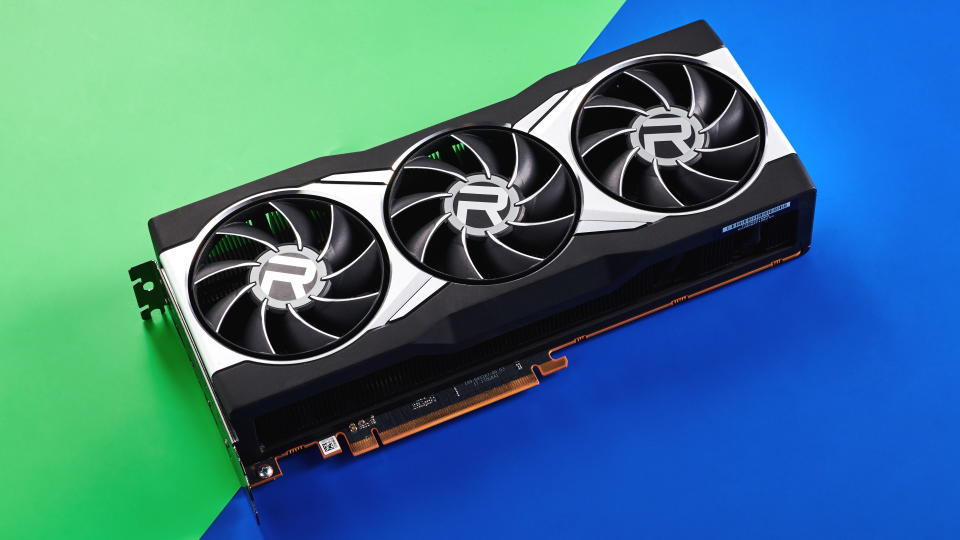
2. AMD Radeon RX 6800 XT
AMD's RDNA 2 architecture at its best
RDNA cores: 4,608 | Base clock: 1,825MHz | Boost clock: 2,250MHz | TFLOPs: 20.74 | Memory: 16GB GDDR6 | Memory clock: 16GT/s | Memory bandwidth: 512GB/s
4K excellence
Cheaper than an RTX 3080
Moderate ray tracing performance
Slower than the 3080 at 4K
As a red team alternative to Nvidia's high-end graphics cards, there have been few finer than the RX 6800 XT. A highly competitive card that comes so close to its rival, with a nominal performance differential to the RTX 3080, is truly an enthusiast card worth consideration for any PC gamer with 4K in their sights.
The RX 6800 XT was the first of AMD's RDNA 2 GPUs to enter the fray, and while we've had plenty of other cards since, this is the one that shines brighter than most and makes the most sense financially. At least it does if you consider its MSRP, and with AMD's GPUs returning to reasonable price levels quicker than Nvidia's, this could actually give the red team the edge in the short term.
We're big fans of what AMD has managed to accomplish with the RX 6800 XT.
A key battleground for Nvidia and AMD this generation has been on the memory front—covering both bandwidth and capacity. The RX 6800 XT comes with 16GB of GDDR6 across a 256-bit bus for a total bandwidth of 512GB/s. That means AMD has Nvidia's 10GB RTX 3080 on the ropes in terms of capacity but falls slightly behind in raw bandwidth to the RTX 3080's 760GB/s.
AMD has an ace up its sleeve in throughput terms in the form of its Infinity Cache, which bolsters the card's 'effective bandwidth' considerably. Some 1,664GB/s, by AMD's making—a 3.25x improvement over the RX 6800 XT's raw bandwidth. In gaming terms, it means you're looking at similar performance, despite the very different underlying technologies.
It's a tough call between the RX 6800 XT and the RTX 3080, but the latter pips AMD to the post with the final touches à la RTX. The RX 6800 XT is $50 cheaper, delivers high 4K performance, and a hefty VRAM increase over the RTX 3080. However, it's easy to argue that an extra $50 dropped on the RTX 3080 is money well spent: a small price to pay for greater 4K performance, much-improved ray tracing, and DLSS. All are available today and with years of developer support in the bank.
That said, AMD's FidelityFX Super Resolution has gained considerable momentum among developers and offers solid upscaling that's worth enabling in supported games. The introduction of FSR 2.0 in Deathloop offers a tantalising glimpse of what the future holds too.
The RX 6800 XT leaves AMD in an incredibly strong position going forward, delivering what is required to get the entire industry to take notice, and with a strong proposition to offer gamers instantly at launch. And it's no surprise to hear the cooperation between Zen and RDNA engineers had a part to play in all this, too.
All of which is to say that AMD has evolved on what was already a promising architecture in RDNA and delivered it in a fantastic graphics card in the RX 6800 XT. And not the least bit impressive in just how swiftly it has achieved near performance parity with Nvidia. There's still some way to go to claw back market share from the green team, but step one on RTG's to-do list (build a high-end GPU) can be confidently checked off with the release of the RX 6800 XT.
We're big fans of what AMD has managed to accomplish with the RX 6800 XT, a return to form for the Radeon Technology Group that injects some much-needed competition into the GPU market and offers a worthy red team alternative for any high-end gaming PC build.
Read our full AMD RX 6800 XT review.
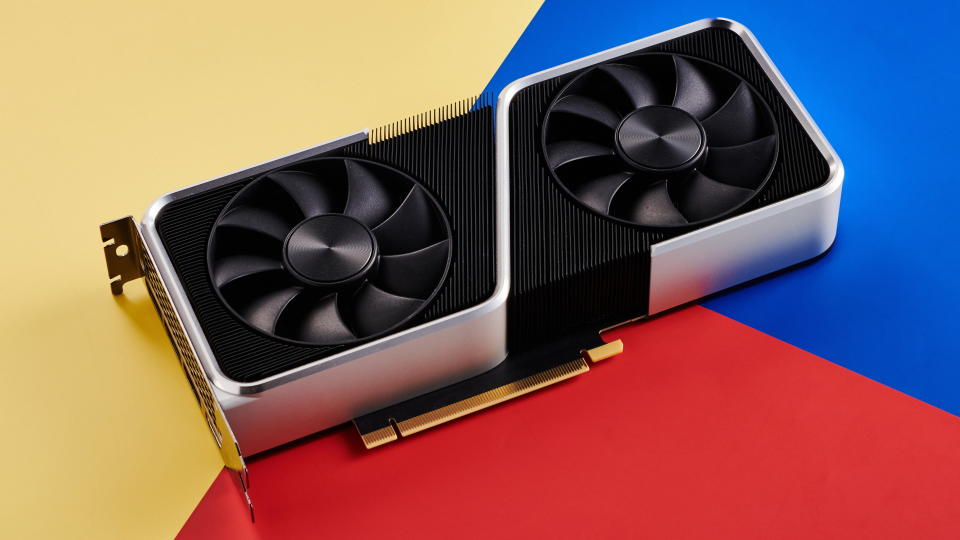
3. Nvidia GeForce RTX 3060 Ti
More affordable Ampere
CUDA cores: 4,864 | Base clock: 1,410MHz | Boost clock: 1,665MHz | TFLOPs: 16.20 | Memory: 8GB GDDR6 | Memory clock: 14GT/s | Memory bandwidth: 448GB/s
Finally! Something a little more affordable
2080 Super performance
Under $400
Chunkier GPU than RTX 3060
Not quite good enough for 4K in all instances
8GB VRAM is less than AMD offers
The best value Ampere to date, the RTX 3060 Ti is very closely related to the RTX 3070. Both utilize the same GA104 GPU (the RTX 3060 Ti has fewer SMs enabled), with the same 8GB of GDDR6 memory across a 256-bit bus.
While 17% less capable in core count than its pricier sibling, the RTX 3060 Ti makes up for it with some judicious GPU Boost frequencies. That partially explains why the RTX 3060 Ti can be within 17% to just single digits off the pace of the RTX 3070, despite operating at a silicon disadvantage. Not bad for a $399 card (if you can find it for that price).
The RTX 3060 Ti delivers gaming performance that's rather stupendous.
If you haven't already done the maths: At $399, the RTX 3060 Ti is 20% cheaper than the RTX 3070, so performance per dollar is on the up with the diminutive graphics card. That's why we love it so; it's a great GPU for the full stack of resolutions and has decent ray tracing capability to boot, courtesy of second-generation RT Cores.
The RTX 3060 Ti delivers gaming performance that's rather stupendous when you look at generational gains over even the RTX 20-series—next to the GTX 10-series, it's quite frightening, actually. There's exceptional 1080p and 1440p performance in a tiny package here, the likes of which would've set you back something close to twice as much cash a couple of years ago. And that's pretty great.
This card is even capable of dabbling with high-fidelity 4K gaming, although you're going to have to massage some graphics settings in order to really crack a solid 60fps in more demanding games. And that's often just in terms of average framerates, to keep your GPU above 60fps requires a lot of tinkering. That can sometimes take the fun out of 4K gaming in the first place. It's a much smoother affair at 1440p, and at 1080p you can pretty much max everything out and just go.
The Nvidia extras can help here too—DLSS, Reflex, and even Nvidia Broadcast all add to the overall experience. There's a solid base of genuinely great features behind RTX and the Nvidia package that's only been improved upon with Ampere, none more so than the ray-tracing performance for that matter.
If the RTX 3080 and RTX 3070 are out of reach, the RTX 3060 Ti certainly makes for a decent stand-in. Perhaps the most impressive demonstration of what this card has achieved is seeing how it stacks up to the 20-series generation: It topples the RTX 2080 Super in nearly every test.
Read our full Nvidia RTX 3060 Ti review (Founders Edition).
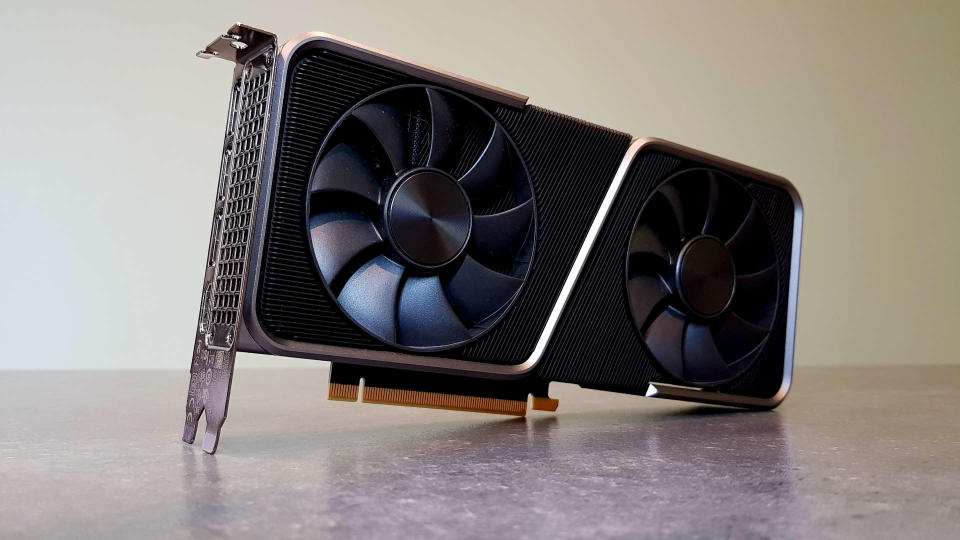
4. Nvidia GeForce RTX 3070
Finally, a reason for every 10-series gamer to upgrade
CUDA cores: 5,888 | Base clock: 1,500MHz | Boost clock: 1,725MHz | TFLOPs: 20.37 | Memory: 8GB GDDR6 | Memory clock: 14GT/s | Memory bandwidth: 448GB/s
Turing-topping frame rates
Relatively low power
This FE card is smol
Often seen priced much higher than an RTX 3060 Ti, especially in pre-built PCs
Perhaps the only high-end Ampere that's anything close to reasonably affordable, the RTX 3070 is also impressive for its ability to match the top-string Turing graphics card, the RTX 2080 Ti, for less than half of its price tag. Sure, it's not exactly a cheap graphics card, but the RTX 3070 is bringing ultra-enthusiast gaming performance down into a far more palatable price point. And it's also making high-end ray tracing and 4K gaming relevant to a much wider sector of the audience too.
At $499, it's still a significant sum by any means—we're talking next-gen console equivalent pricing here—but it's hardly an exorbitant sum when compared to PC gaming's top graphics silicon today. In return, you're gifted a 4K-capable graphics card that doesn't require too much fiddling to reach playable, if not high, framerates. And it'll absolutely smash it at 1440p, no question about that.
The RTX 3070 Founders Edition is still sporting the 12-pin power connector of the RTX 3080, and therefore it comes with a single 8-pin to 12-pin adapter in the packaging. Nvidia has once more delivered a super-compact PCB with this FE card, however, which makes the whole shroud far smaller than the RTX 3080.
This is the Ampere card which represents a genuine performance upgrade for the vast majority of us, at a price that we can almost swallow.
Despite coming with two front-loaded fans the spinner at the tail of the card is there to amplify the airflow across the heatpipes and that does seem to aid the cooling performance of this smart little GPU.
The RTX 3070 also offers up Nvidia's reliable driver stack, the GeForce Experience app, ShadowPlay's recording, and the new Broadcast suite, the impressive Reflex latency-spiking setup, and the latent potential of RTX IO bringing the next-gen consoles' most potent feature to the PC. And of course, you have ray tracing and the ever-improving DLSS enhancements.
That's a lot to add onto the impressive raw performance that the RTX 3070 offers, and it does make a difference to a lot of people.
Nvidia's xx70 series of cards is often the real sweet spot for PC gamers, and the RTX 3070 is ever that. This is the Ampere card which represents a genuine performance upgrade for the vast majority of us, at a price that we can almost swallow. For all those people who sat on their GTX 1080 and GTX 1080 Ti cards throughout the RTX 20-series, now really is the time to upgrade.
Read our full Nvidia RTX 3070 review (Founders Edition).
Best CPU for gaming | Best DDR4 RAM | Best gaming motherboards
Best SSD for gaming | Best gaming laptop | Best gaming monitors
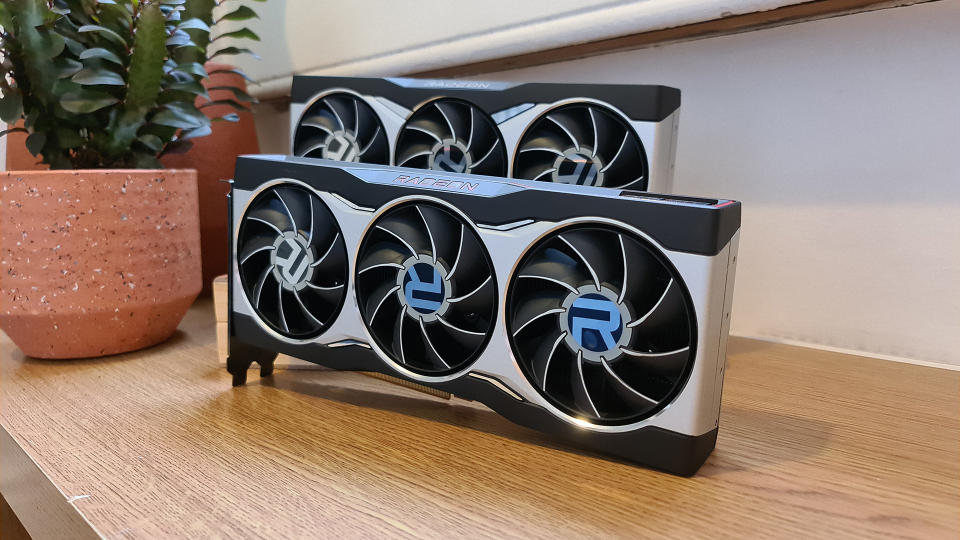
5. AMD Radeon RX 6900 XT
If you've money to burn
RDNA cores: 5,120 | Base clock: 1,825MHz | Boost clock: 2,250MHz | TFLOPs: 23.04 | Memory: 16GB GDDR6 | Memory clock: 16GT/s | Memory bandwidth: 512GB/s
Occasional RTX 3090 performance…
...but cheaper!
Can lag behind RTX 3080 at times
Mediocre ray tracing performance
The RTX 3090 may have sat unchallenged at the top rungs of graphics performance at launch, but it wouldn't be long until AMD rustled together a challenger in the RX 6900 XT, or 'Big Navi.' The RX 6900 XT hopes to knock Ampere's finest from its perch on high and send it spiralling back down to Earth. And it gets kind of close, too, with 4K performance a little off the pace of the RTX 3090—and all for one-third off the asking price.
For that reason, it's simply the better buy for any PC gamer without any ulterior motives of the pro-creator variety. But there's a reason it's not number one in our graphics card guide today, and that's simply due to the fact it's not that much better than an RTX 3080, and sometimes not at all. It's another $300 on top of the RTX 3080's recommended price tag, and you'd hope for higher performance in both rasterized and ray tracing workloads. Yet, inevitably its ray-tracing acceleration lags behind the competition.
For raw gaming alone, the RX 6900 XT is a cheaper alternative to the RTX 3090.
Even within AMD's line-up, there's no pressing argument to pick this up over more-affordable offerings. With a $350 price premium over the RX 6800 XT, the RX 6900 XT offers little return on your sizeable investment—the RX 6900 XT is 53% more expensive than the RX 6800 XT yet offers just 5.25% more performance in games.
That's why it's strange that AMD is making a point of the RX 6900 XT being a card built for 'gaming first'. Even Nvidia didn't make that mistake, billing the RTX 3090 as a pro-creator card with a substantial increase in memory capacity over the second-run gaming card below to help justify the cost.
It's far more difficult to justify the cost of the RX 6900 XT, sharing as many qualities with far cheaper cards as it does and with the slight performance gain it's able to deliver from its few upgrades.
While I'm a big fan of RDNA 2 and the leaps AMD RTG has made to get it to compete at this level in a short period of time are impressive, the RX 6900 XT is simply not its finest form. It's not the easiest card to recommend for the vast majority of gamers, even those that have their sights set on the high-end. For most, the RTX 3080 is still the card to beat.
But the RX 6900 XT does come with assurances that the RTX 3080 can't make, such as its 16GB of GDDR6 memory, which is a whole 6GB greater than the 10GB of (faster) GDDR6X memory on the green team card. With that in mind, for raw gaming alone, the RX 6900 XT is a cheaper alternative to the RTX 3090.
AMD has since released the RX 6950 XT to compete mano a mano with Nvidia's more recent RTX 3090 Ti. Both of these cards are extreme in performance, and price: demanding well over $1,000. The RX 6900 XT is generally slipping to MSRP or less at the moment, however, and that's why we prefer it as the high-end option today.
Read our full AMD RX 6900 XT review.

6. Nvidia GeForce RTX 3080 Ti
The new king of GeForce gaming
CUDA cores: 10,240 | Base clock: 1,365MHz | Boost clock: 1,665MHz | TFLOPs: 34.10 | Memory: 12GB GDDR6X | Memory clock: 19GT/s | Memory bandwidth: 912.4GB/s
Superb 4K performance
Nearly an RTX 3090 for less cash
Excellent ray tracing capability
A lot pricier than the RTX 3080
Power hungry at 350W
Runs pretty hot
The RTX 3080 Ti isn't the mightiest GeForce graphics card that Nvidia makes. That accolade originally went to the RTX 3090, by a hair, and was more recently claimed by the RTX 3090 Ti. Though when all is said and benchmarked, it is the uber high-end RTX 3080 Ti that we'd recommend to any PC gamer looking to go all out on their next build.
The arrival of the Ampere generation did a lot to diminish the awkwardness or fiddly nature of 4K gaming, but the RTX 3080 Ti truly squashes it. Setting up for high performance 4K gaming remains a pricey investment, but you needn't be as cautious as we once had to be on a game-by-game basis. You can relatively comfortably set your game to high or ultra settings and get comfortable, even high, frame rates at 4K.
With performance close to the RTX 3090 at 4K, the RTX 3080 Ti is as much a gaming graphics card as its progenitor.
The last thing you want when gaming at 4K is to turn down graphics quality settings, and with the RTX 3080 Ti you shouldn't have to nearly as much as we've come to expect at 3840 x 2160.
The RTX 3080 Ti tends to fall a little behind the RTX 3090, although it appears the more expensive card only sees marginal benefit for an increase in core counts and memory—the RTX 3080 Ti is only single percentage points off the pace.
With performance close to the RTX 3090 at 4K, the RTX 3080 Ti is as much a gaming graphics card as its progenitor. With a vast bounty of CUDA Cores and speedy GDDR6X memory, this card demolishes any game you can throw at it with relative ease. It's also more than capable of real-time ray tracing, courtesy of 80 RT Cores.
The GeForce RTX 3080 Ti remains an impressively powerful graphics card despite some inflexibility ingrained in the price—it will see some save a few pennies on ultra-high-end gaming PC builds and still claim top performance. The Ampere architecture is excellent, and stuffing more of it under that unassuming black and (polished) grey shroud simply makes for a great gaming chip.
It does, then, achieve what it set out to do: break the back of just about any game, API, or graphics-intensive task, even at 4K, and do so in a way that appeals directly to gamers' sensibilities. Though it's not quite the high-end price-to-performance champion the RTX 3080 is, the RTX 3080 Ti FE is in small part a better buy than an RTX 3090 FE.
The reason we don't rate this card higher up in our list of the best graphics cards, however, is down to its price. Launching at $1,200, it's only a stone's throw away from the $1,499 RTX 3090. Massively inflated pricing, or lack of stock, notwithstanding.
Read our full Nvidia RTX 3080 Ti review (Founders Edition).

7. Nvidia GeForce RTX 3060 12GB
Nvidia's shot at a more affordable Ampere GPU
CUDA cores: 3,584 | Base clock: 1,320MHz | Boost clock: 1,777MHz | TFLOPs: 12.74 | Memory: 12GB GDDR6 | Memory clock: 15GT/s | Memory bandwidth: 360GB/s
Ready for 60fps at 1440p or greater
Decent gen-on-gen performance improvement
More readily available to purchase in pre-built PCs
Not always massively faster than an RTX 2060
RTX 3060 Ti is a better buy at $399
The decision to load the RTX 3060 with 12GB of GDDR6 memory appeared a strange one at first, and in many ways it still is. It's more memory than the RTX 3080, after all, albeit slower stuff, and it tops out the RTX 3060 Ti too. However, the RTX 3060 wields it well, managing to dispatch the RTX 2060 by a large margin in most games, and by enough of a gap in the rest to make it worthwhile.
The RTX 3060 is a fine upgrade for a 10-series or older card, especially if at close to the MSRP.
And we're not going to turn our noses up at 12GB of VRAM when 6GB is the likely alternative.
Perhaps the most newsworthy shake-up for the Nvidia RTX 3060 came with the announcement of a hash rate limiter, which was designed to keep the card from operating at its full capability while mining Ethereum, the crypto of choice for GPU mining. Nvidia hoped that'd sway miners towards its new CMP line-up, built from off-cut GPUs not fit for gaming consumption, while supposedly leaving more GeForce cards for gamers. It didn't stop the card from selling out of course.
With a decent generation-on-generation improvement and plenty of speed at 1080p and 1440p, the RTX 3060 12GB is a graphics card easily argued for.
It's also nominally cheaper than the RTX 2060 was on launch day, though it's not so easy to find it as a discrete number nowadays. That said, this card often crops up within pre-built gaming PCs, and for a decent price all-inclusive too.
The RTX 3060 Ti remains the mid-range champion. The Nvidia RTX 3060 strays a little too far from the pack of high-end Ampere to have the same impact generation on generation. But in that same breath, it must be said that the RTX 3060 is a fine upgrade for a 10-series or older card, especially if at close to the MSRP, and one that will likely see you confidently through the next few years of major game releases.
Read our full Nvidia GeForce RTX 3060 12GB review (Zotac Twin Edge).
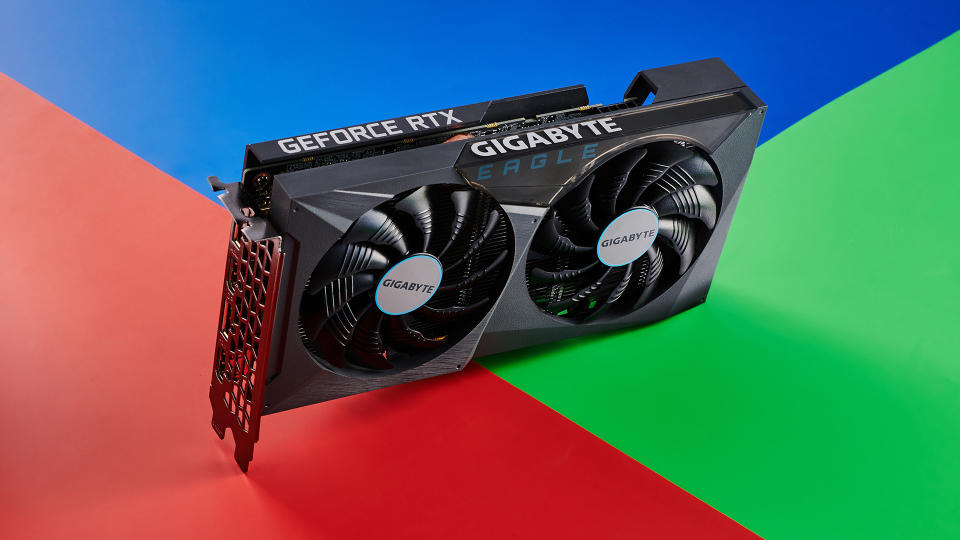
8. Nvidia GeForce RTX 3050
The best sub-$300 graphics card, in theory
CUDA cores: 2,560 | Base clock: 1,552MHz | Boost clock: 1,777MHz | TFLOPs: 9.098 | Memory: 8GB GDDR6 | Memory clock: 14GT/s | Memory bandwidth: 224GB/s
DLSS and ray tracing support
Way faster than an RX 6500 XT
Should be at least RTX 2060 performance
Long term stock and pricing unknowable
There is no graphics card under $300 that we would recommend bar the GeForce RTX 3050. Though it didn't take much to defeat AMD's Radeon RX 6500 XT. The RTX 3050 is still a difficult GPU to recommend heartily, however, as it's neither readily available nor as cheap as it should be.
The RTX 3050 is a much smaller GPU than the RTX 3060 12GB, and like any good PC gamer, we would recommend the larger chip. That said, if you can't stretch your budget any further, the RTX 3050 will deliver GTX 1660 Ti performance with the benefit of DLSS.
As the basis of a prebuilt gaming PC, the RTX 3050 is the better option of what's out there on a tight budget.
That means you're getting a graphics card that can handle 1080p at decent settings most of the time, although some titles will push you well below the 60fps goal many of us aim for. And while this may be the most affordable Nvidia graphics card of this generation, it's still a hefty chunk of cash when you can't just whack everything on full and enjoy your game of choice the way it was meant to be played.
There's also support for ray tracing with the RTX 3050, though its weak-heart innards aren't going to stand for much of that.
Where we wanted at least RTX 2060 performance, we ended up with GTX 1660 Ti frame rates with a little RTX frosting on top. Sure, that's tasty where it sticks, but is another example of a card designed and priced within the limits of a pandemic and a GPU shortage, rather than showing off Nvidia's silicon wizardry to its fullest.
As the basis of a prebuilt gaming PC, the RTX 3050 is the better option of what's out there on a tight budget. That said, you can find really good RTX 3060 12GB PC deals fairly regularly, and with a little patience, you may be able to grab a much more capable graphics card.
Read our full Nvidia GeForce RTX 3050 review (Gigabyte Eagle).
GPU benchmarks
Every new GPU generation offers new features and possibilities. But rasterized rendering is still the most important metric for general gaming performance across the PC gaming world. Sure, Nvidia GPUs might well be better at the ray tracing benchmarks they more or less instigated, but when it comes to standard gaming performance AMD's latest line up can certainly keep pace.
It's also worth noting that the previous generation of graphics cards do still have something to offer, with something like the GTX 1650 Super able to outpace a more modern RTX 3050 in most benchmarks.
We're not saying you should buy an older card in 2022, but it's worth knowing where your current GPU stacks up, or just knowing the lie of the land. But there is also the fact there will be gaming rigs on sale with older graphics cards over the next few days, and if they're cheap enough they may still be worth a punt as a cheap entry into PC gaming.
We've benchmarked all the latest GPUs of this generation, and have tracked their performance against the previous generation in terms of 3DMark Time Spy Extreme scores. Where we don't have the referential numbers for an older card we have used the average index score from the UL database. These figures track alongside an aggregated 1440p frame rate score from across our suite of benchmarks.

Graphics card FAQ
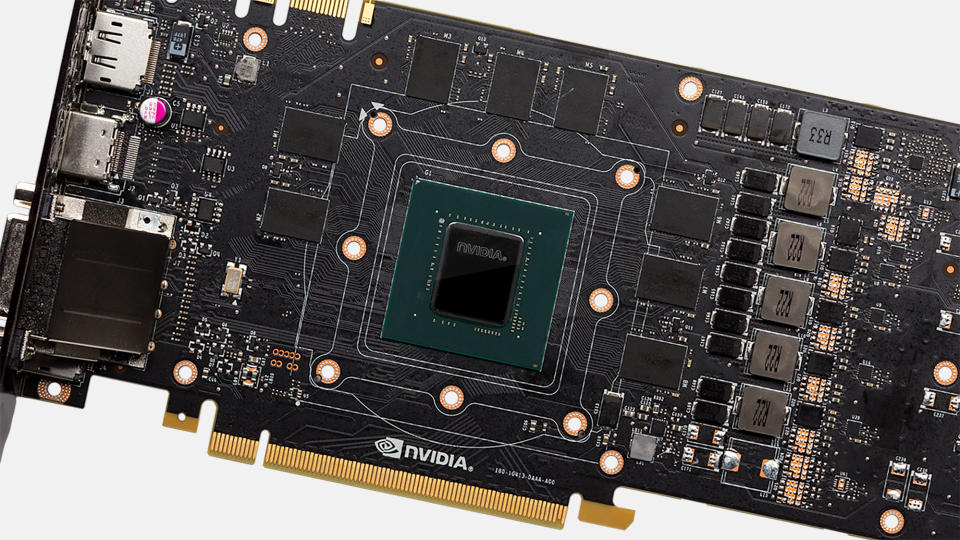
How do I get a GPU in the the graphics card shortage?
Prices are starting to drop down to normal levels, with stock levels returning in full force. The issue that remains is finding a graphics card without a massive markup, as we don't believe you should be overpaying for a GPU today, not with the next generation around the corner.
Which is better GTX or RTX?
The older GTX prefix is now used to denote older Nvidia graphics cards which don't have the extra AI and ray tracing silicon that the RTX-level cards do. This RTX prefix was introduced three years ago with the RTX 20-series, and highlights which cards have GPUs which sport both the Tensor Cores and RT Cores necessary for real-time ray tracing and Deep Learning Super Sampling.
Is ray tracing only for RTX cards?
The RTX prefix is only used to denote cards which house Nvidia GPUs with dedicated ray tracing hardware, but they are still using the same DirectX Raytracing API Microsoft has created, and which is used by AMD's RDNA 2 GPUs. These AMD GPUs are able to suport real-time ray tracing, though with a higher performance impact than on Nvidia's GPUs.
Intel's upcoming Xe-HPG GPUs, with the Alchemist graphics cards first to use them, will also support ray tracing using Microsoft's DirectX Raytracing API when they launch early next year, too.
Is SLI or CrossFire still a thing?
If you're looking for maximum performance, you used to run two cards in SLI or CrossFire. However, it's become increasingly common for major games to ignore multi-GPU users completely. That includes all DXR games. There's also the fact that fewer of the next-gen cards actually support the linking of two cards. On the Nvidia side, only the $1,500 RTX 3090 comes with NVLink connections, only for creative apps.
So, no. It's not a thing.
Do I need a 4K capable graphics card?
The obvious answer is: Only if you have a 4K gaming monitor. But there are other things to consider here, such as what kinds of games do you play? If frame rates are absolutely king for you, and you're into ultra-competitive shooters, then you want to be aiming for super high fps figures. And, right now, you're better placed to do that at either 1440p or 1080p resolutions.
That said, the more games, such as CoD: Warzone that incorporates DLSS, the more Nvidia cards will be capable of making a close approximation of 4K visuals on your 4K monitor, but at higher frame rates.
What's a Founders Edition graphics card?
The Founders Edition cards are simply Nvidia's in-house designs for its graphics cards, as opposed to those designed by its partners. These are usually reference cards, meaning they run at stock clocks.
Briefly, for the RTX 20-series, Nvidia decided to offer Founders Editions with factory overclocks. These had made it a little difficult to compare cards, as Founders Edition cards give us a baseline for performance, but Nvidia has since returned to producing them as reference again.
